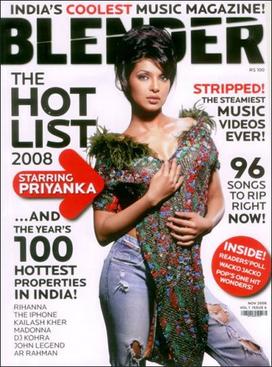 Issue 2.1 from 1995, featuring Björk | |
| Editor-in-Chief | Dale Hrabi |
|---|---|
| Former editors | Regina Joseph (Founding Editor-in-Chief), Howard Stringer |
| Categories | Music |
| Frequency | 10 times per year |
| Founded | 1994 |
| First issue | August 1994 (CD-ROM) June–July 2001 (Print) |
| Final issue | June 1997 (CD-ROM) April 2009 (Print) |
| Company | Dennis Publishing |
| Country | United States |
| Based in | New York |
| Language | English |
| Website | Blender.com |
| ISSN | 1534-0554 |
| OCLC | 34610465 |
Blender was an American music magazine published from 1994 to 2009 that billed itself as "the ultimate guide to pop culture". [1] It was also known for sometimes steamy pictorials of celebrities. It compiled lists of albums, artists, and songs, including both "best of" and "worst of" lists. In each issue, there was a review of an artist's entire discography, with each album being analyzed in turn.
Blender was published by Dennis Publishing. The magazine was created by founding Editor-in-Chief Regina Joseph as the first digital magazine, delivered entirely on CD-ROM disc and before the development of graphical browsers required to view the web. [2] [3] [4] [5] [6] [7] [8] [9] She brought in co-founders Jason Pearson and David Cherry, and Blender's original publisher, Felix Dennis/Dennis Publishing, UK. [3] [5] [10] [8] Joseph's CD-ROM editions of Blender also featured the first forms of digital advertising. [4] [10] [5] [6] [8] Felix Dennis published 15 digital CD issues, and launched a web version in 1996. [11] The final CD-ROM issue was published in June 1997, issue 14. [12] Dennis started publishing a print edition again in June 2001, [13] which became the final distribution format of the title. Blender CD-ROM showcased the earliest digital editorial formats, as well as the first forms of digital advertising. The first digital advertisers included SonicNet, [10] [4] Time-Life/Philips, [8] [4] Calvin Klein, Apple Computer, Toyota and Nike.
In June 2006, the Chicago Tribune placed Blender eighth in a list of the 50 best magazines, describing it as "the cool kid at the school of rock magazines". [14]
Owner Alpha Media Group closed Blender March 26, 2009, going to an online-only format in a move that eliminated 30 jobs and reduced the company's portfolio of titles to Maxim alone. Blender's final print issue was the April 2009 issue. [15] Subscribers to the magazine were sent issues of Maxim magazine to make up for the unsent Blender issues.
